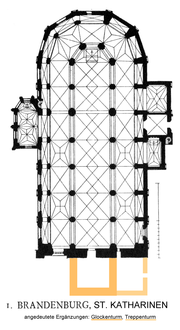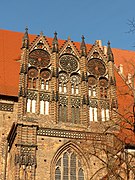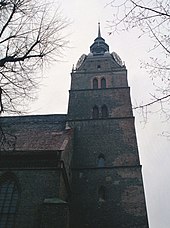St. Katharinen (Brandenburg an der Havel)

Sankt Katharinen is a three-aisled late Gothic hall church and the Protestant parish church of the Neustadt in Brandenburg an der Havel . It is one of the brick Gothic churches with the richest architectural sculptures and furnishings and is the largest church in the city.
Building

Building history
Until 1395 a stone church stood on the site of the Katharinenkirche. After 1381, the Szczecin builder Hinrich Brunsberg began building the new Katharinenkirche, the largest church in the city. It was consecrated in 1401 to St. Catherine , St. Amalberga and St. Nicholas . According to the dendrochronological dating of the roof structure 1399–1400 (d), this date on an inscription in the north chapel can only be related to the completion of the nave hall without vaults. The north chapel itself was only completed later after a change of plan and consecrated in 1434; The southern Schöppenkapelle can also be dated around this time. The ambulatory choir was not covered until 1426 (d) and was vaulted before the middle of the 15th century. At the end of the 15th century, the south vestibule followed with a library on the upper floor in front of the south portal.
The Romanesque west building of the previous building was initially reused and was largely renewed around 1494 with brick lining and cladding. This western building had to be rebuilt after the collapse of the northern half of the tower in 1582, as described below. Further renovations took place in the years 1725 and 1842 (inside), 1864/65 (outside), 1910/12 and 1987 (inside, with the restoration of the medieval room layout based on findings) and from 1992 (outside).
Building description
The dimensions of the church with a length of 73 m and a width of 29 m are remarkable. The roof reaches 38 m. The height of the imposing roof truss , a masterpiece of late medieval carpentry that can be viewed , exceeds the height of the ship to the eaves . The tower is 72.5 m high. In the first construction phase, the ship was completed with a smooth east gable , which can still be seen very clearly from the height of the roof structure. Only later was a polygonal hall choir with access added. The buttresses are drawn inwards and form deep window niches, which, however, are connected to one another by narrow, ogival openings in the pillars. The central nave is spanned by a parallel ribbed vault, which ultimately goes back to that of St. Vitus Cathedral in Prague. In the ambulatory, the uneven refractions of the outer polygon from five sides of a decagon and the inner pillars create cross-ribbed vaults alternating with three-beam vaults. The side chapels show various star vault shapes.
Exterior fittings
The decor of the outer walls is made of burnt material, form bricks and terracotta sculptures a splendor that otherwise almost entirely of the stone is known gothic. The larger than life terracotta sculptures in particular are unique.
The two side chapels are particularly impressive, which instead of the transept arms give the building a cross-shaped floor plan. Their towering gables with eyelashes and air windows full of tracery between pinnacle towers are additionally stabilized by folding the facade line:
- The Marienkapelle on the north side has the richest furnishings.
- The Schöppenkapelle on the south side is only a little behind.
With its imposing size and furnishings, the St. Catherine's Church was intended to illustrate the claim of the New Town of Brandenburg in the Middle Ages to be the richest, most distinguished and most important town in the Mark Brandenburg with its sister town on the opposite bank of the Havel .
Interior
The church has an artistically valuable, extremely rich furnishings from the Middle Ages to the recent past.
The high altar is a winged altar with two pairs of wings, which was created by G. Weger according to an inscription in 1474. It was restored and redesigned in 1842, and further restorations took place later. In the shrine, the Madonna is shown in carved figures under richly carved canopies and in the wings depictions of the childhood of Jesus. In the first change there are painted scenes from the lives of the saints, on the outside of the wings the Passion of Christ. In the predella there are five scenes from the legend of Saint Catherine. In conversation narrowness of the Cross and Christ before the side are segmental arches reliefs Pilate and Christ in Limbo attached. In front of the altar are two brass candlesticks from around 1500 with claw feet.
The pulpit is a work donated in 1668, which has since been restored several times. The polygonal basket is supported by a figure of Paul and shows figures of Christ and the apostles in shell niches with winding columns and cartilage at the entrance . The sound cover with the openwork lantern is surrounded by angels with the instruments of suffering and is crowned by the risen One.
The baptism was cast in brass by D. Molner in Erfurt in 1440 and is in the north chapel. The octagonal cauldron stands on a round base studded with four dragons and is surrounded by four lions. The baptism of Christ, the twelve apostles and the church patrons Katharina and Amalberga are depicted on the wall under tracery arcades . The lid with an eight-sided canopy is crowned by a tall pinnacle with the pelican as a symbol of Christ's self-sacrificing love. The ornamental arcades below are broken up into fine frameworks, on the front a Madonna is depicted in the glory of rays.
The Dutch-influenced Hedwig's altar from around 1480 in the Schöppenkapelle to the south shows figurative representations of St. Hedwig between the plague saints Rochus and Adrianus of Nicomedia under canopies in the shrine . On the wings there are artistic paintings from the lives of St. Hedwig, St. Rochus and Adrianus, as well as a depiction of Gregory's mass . In the predella there are depictions of Anna herself , the Sorrowful Mother and Antonius.
All glass windows were designed and made by Otto Linnemann from Frankfurt in 1912 . Numerous epitaphs and tombs are also to be mentioned.
organ
The main organ was built in 1898 by Wilhelm Sauer from Frankfurt / Oder. The richly decorated baroque prospectus is from the previous Wagner organ and was made by Johann Georg Glume in 1726/27 . The instrument has 48 registers on three manuals and a pedal . In 2019 there will be a restoration by Schuke Orgelbau with an extension.
The choir organ was built by Jehmlich Orgelbau from Dresden and was originally in the Paulikapelle. It has been in the Katharinenkirche since 2005. The instrument has 12 registers with two manuals and pedal and mechanical action.
tower
Tower dimensions and collapse
The tower reaches a height of 72.5 m.
A disaster struck the church on March 30, 1582 at 3:00 a.m. The tower had already cracked during a hurricane in 1580 and was three inches from the gable when measured in 1582. On the night of March 29th to 30th, 1582, the three art piper journeyman Anton Störtewein, Andreas Drichel and Georg Wolff slept in the art piper apartment on the upper floors of the tower. Your teacher, the art piper Martin Nehring, was away. Störtewein had just blown the hour when the tower collapsed. The journeymen concerned were lucky: Störtewein suffered a cut wound on his left ear, Drichel dug a “rough piece of wood” into his hip and Wolff was injured in one leg. All three survived the accident with these minor injuries. When the tower collapsed, the west wall with the organ suspended from it was smashed.
reconstruction
The Milanese builder Johann Baptista de Sala rebuilt the tower and closed it off with a "lost roof". De Sala returned to Milan after the council of the Neustadt Brandenburg could no longer pay him. Ten years later the reconstruction of the tower with the octagonal dome and the openwork lantern was completed. This work was completed by the master carpenter Balthasar Richter from Dresden. Richter's origins seem to be reflected in the shape of the top of the tower, as the shape, size and shape of the lantern bears an astonishing resemblance to the tower covering of the old Dresden Kreuzkirche , as shown by an engraving from the building from 1680. It is an octagonal structure with a dome and an openwork lantern. Michael von Utrecht covered the spire with lead and used 60 quintals of lead.
Current situation
From 2005 onwards the tower was closed to visitors. An expert opinion commissioned by the St. Katharinen Church Tower Association showed that the wood of the upper tower construction had been treated with the DDT -containing wood preservative Hylotox before 1989 . Over time, all of the dust in the upper tower areas became contaminated with DDT.
Roof turret
Until 1734 the church had a roof turret that carried the bells "Salvator", "Johannes" and "Maria". Due to its dilapidation, it was removed without replacement in 1734 and the bells moved to the main tower. The roof structure, which was particularly reinforced at this point, still bears witness to the former roof turret.
Library
The parish of St. Katharinen has a remarkable library from the late Middle Ages, the Reformation and the post-Reformation period. It comprises a total of 3598 works in 1550 volumes. Among them are writings from the possession of important scholars such as the Garcaeus family, Georg Sabinus , Johannes Mathesius , Abdias Praetorius and others. The collection also includes incunabula from the early days of European letterpress printing. Furthermore, the library of St. Katharinen, which has been stored in the monastery archive of the cathedral since 1951 , has a valuable, medieval music library. It comprises 350 manuscript volumes and 319 pieces of music that go back to the 16th century. The church library of St. Katharinen is the youngest of the three church libraries in the city of Brandenburg an der Havel. It was founded in 1634 when Joachim Garcaeus acquired the posthumous private library .
Specialty
After the battle of Lützen , the dead King Gustav Adolf was laid out in the course of his transfer to Sweden from December 11th to 19th, 1632 in St. Katharinen zu Brandenburg an der Havel, “as the arrival of the Queen's widow, Marie Eleonore , is here Daughter of Mark, wanted to wait ... “.
location
The church is located in the center of the new town of Brandenburg on the geographically highest site of the medieval town's foundation.
Traditionally, the Katharinenkirche was always completely framed by residential and functional buildings. There were only four narrow access roads: a narrow lane from Steinstrasse, then Kirchgasse (only 2.65 m wide until 1886, then expanded to 8 m wide), then the entrance south of Gumpert's house on Paradeplatz (main street) and a slip through from the main road. The narrow lane between the lots at Hauptstrasse 8 and 10, as well as the lane opposite Paulinerstrasse (formerly Klappgasse) between Steinstrasse and Katharinenkirchplatz are nameless and only passable on foot.
The reason was the use of the Katharinenkirchplatz as a churchyard / cemetery between 1333 (first documented mention) and 1809 (last burial 1788), as it is clearly shown on the so-called Hedemann plan from 1722-1724. From the Middle Ages to modern times, there was no market activity or social life around the church. With the storming of Neustadt by the Soviet Army in the last days of World War II , important patrician houses such as the Kurfürsten- or Storbeck'sche Haus and the Riedel'sche Haus (today's location of the historic post-mile column), which is adjacent to the main street, fell victim to the fighting.
Since then, the view of the choir of the Katharinenkirche on the southeast corner of the Katharinenkirchplatz has been free. A total of seven parcels were not rebuilt and thus provide generous access to Katharinenkirchplatz. The area of the southern Katharinenkirchplatz is currently used as a market.
Web links
- Entry in the monument database of the State of Brandenburg
- Katharinenkirche on one side of the city of Brandenburg
- Brandenburg Sankt Katharinen on the website of the Evangelical Church District Mittelmark-Brandenburg
- The imposing roof structure of the St. Katharinen Church . In: Preußischer Landbote , Culture section, 2nd volume, from July 2, 2005
literature
- Otto Tschirch : History of the Chur and capital Brandenburg in two volumes . Brandenburg (Havel) 1928
- Friedrich Grasow: Brandenburg - the millennial city. A walk through the culture and architecture of past centuries . Self-published by the city of Brandenburg, 1928
- Nikolaus Zaske: Hinrich Brunsberg . In: Ule Lammert (ed.): Great builders . Berlin 1990, ISBN 3-362-00455-5 , Volume 2, p. 9 ff.
- Marcus Cante: Monument Topography Federal Republic of Germany, Monuments in Brandenburg, City of Brandenburg an der Havel, Cathedral Island - Old Town - Neustadt , Volume 1.1. Wernersche Verlagsgesellschaft, Worms am Rhein 1994, ISBN 3-88462-105-X , pp. 281 ff., 304 ff., Um
- Georg Dehio : Handbook of the German art monuments. Brandenburg. Deutscher Kunstverlag, Munich / Berlin 2000, ISBN 3-422-03054-9 , pp. 126-135.
Individual evidence
- ↑ Section on Katharinenkirche Brandenburg based on the Brandenburg Monument Topography 1994 Vol. 1.1. Retrieved December 27, 2017 .
- ↑ a b Georg Dehio: Handbook of German Art Monuments. Brandenburg . Deutscher Kunstverlag, Munich / Berlin 2000, ISBN 3-422-03054-9 , p. 126-134 .
- ^ About the organs Look behind the organs Märkische Oderzeitung from June 11, 2014
- ↑ St. Katharinen organ with history and disposition
- ↑ Record order for organ builder Schuke Potsdamer Latest news from November 6, 2018
- ↑ St. Katharinen choir organ with history and disposition
- ↑ Kulturspiegel, No. 11/1968, pp. 23-27., In: The Brandenburg honorary citizen Friedrich-Karl Grasow on his 100th birthday. Edited by Klaus Heß and Anke Richter on behalf of the Historisches Verein Brandenburg (Havel) e. V. and the city administration of Brandenburg an der Havel. Brandenburg an der Havel 2012, ISBN 978-3-943463-03-3 , p. 79.
- ↑ Heimat = reading sheet. Edited by the teachers 'and teachers' association Brandenburg (Havel) e. V. 3rd school year 1st sheet.
- ^ Anton Weck: Kreuzkirche Dresden, 1680
- ↑ Brandenburger Anzeiger , May 28, 1929. Reprinted in: The Last Century, Festschrift for the 600th anniversary of the St. Catherine's Church in Brandenburg an der Havel + AD 2001 . Editing Pastor Michael Kiertscher, Brandenburg 2001
- ↑ Entry in the manual of the historical book inventory online
- ↑ Otto Tschirch: History of the Chur and capital Brandenburg in two volumes . Brandenburg (Havel) 1928, Volume 2, p. 39
Coordinates: 52 ° 24 ′ 32.1 ″ N , 12 ° 33 ′ 41.7 ″ E



















